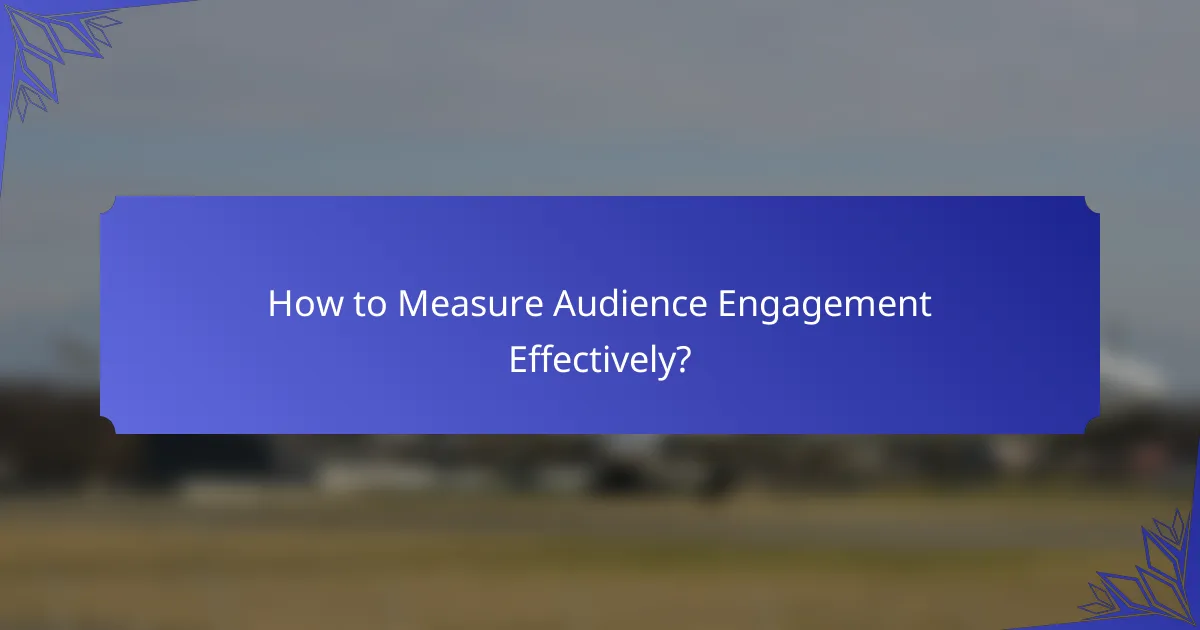Social media has become a vital tool for market research, enabling businesses to gather valuable insights into consumer preferences and behaviors. By staying attuned to current trends, such as the rise of short-form videos and influencer marketing, brands can adapt their strategies to enhance audience engagement. Additionally, measuring key metrics like likes and shares helps companies understand how well their content resonates with their target audience.

How to Leverage Social Media for Market Research?
Leveraging social media for market research involves gathering insights about consumer preferences, behaviors, and trends through various online platforms. This approach allows businesses to make data-driven decisions and tailor their strategies to better engage their target audience.
Utilizing Surveys on Platforms
Surveys on social media platforms can effectively gather direct feedback from users. Tools like Facebook Polls or Instagram Stories allow brands to ask specific questions and receive immediate responses, making it easy to gauge public opinion on products or services.
When designing surveys, keep questions concise and focused. Aim for a mix of multiple-choice and open-ended questions to capture both quantitative and qualitative data. Offering small incentives, like discounts or giveaways, can also boost participation rates.
Analyzing Engagement Metrics
Engagement metrics, such as likes, shares, comments, and click-through rates, provide valuable insights into how audiences interact with content. By analyzing these metrics, businesses can identify which types of posts resonate most with their audience and adjust their content strategies accordingly.
Regularly track these metrics using platform analytics tools. Look for patterns over time to understand what drives engagement. For example, if video content consistently receives higher engagement than images, consider prioritizing video in your marketing efforts.
Tracking Competitor Activity
Monitoring competitors on social media can reveal market trends and consumer preferences. By observing their content strategies, engagement levels, and audience interactions, businesses can identify gaps in their own approach and adapt accordingly.
Use tools like Sprout Social or Hootsuite to track competitor posts and engagement metrics. Create a competitive analysis report to summarize findings and highlight opportunities for differentiation in your own social media strategy.
Using Social Listening Tools
Social listening tools help brands monitor conversations about their products, industry, or competitors across social media platforms. This approach enables businesses to identify emerging trends, customer sentiments, and potential issues before they escalate.
Popular tools like Brandwatch or Mention can provide insights into brand perception and customer needs. Set up alerts for specific keywords related to your brand or industry to stay informed about relevant discussions and feedback.
Conducting Focus Groups Online
Online focus groups allow businesses to gather qualitative insights from targeted consumer segments. By using video conferencing tools, brands can engage directly with participants to explore their opinions and experiences in-depth.
Recruit participants through social media channels or existing customer databases. Prepare a structured discussion guide to ensure all relevant topics are covered. Record sessions for later analysis, and consider offering participants a small incentive for their time.

What Are the Current Social Media Trends in the US?
Current social media trends in the US highlight a shift towards engaging formats like short-form videos, augmented reality experiences, and influencer marketing. These trends reflect changing user preferences and the need for brands to adapt their strategies to maintain audience engagement.
Rise of Short-Form Video Content
Short-form video content has surged in popularity, driven by platforms like TikTok and Instagram Reels. These videos, typically lasting from 15 seconds to a minute, capture attention quickly and encourage high engagement rates.
Brands can leverage this trend by creating authentic, relatable content that resonates with their target audience. Consider using storytelling techniques and trending music to enhance appeal and shareability.
Increased Use of Augmented Reality
Augmented reality (AR) is becoming a key tool for brands to enhance user experience on social media. AR features, such as filters and virtual try-ons, allow users to interact with products in a more immersive way.
To effectively utilize AR, brands should focus on creating engaging experiences that align with their identity. For example, beauty brands can offer virtual makeup trials, while retailers can enable customers to visualize furniture in their homes.
Growth of Influencer Marketing
Influencer marketing continues to grow as brands recognize the value of authentic endorsements from trusted figures. Collaborating with influencers can help brands reach niche audiences and build credibility.
When engaging with influencers, it’s crucial to choose individuals whose values align with your brand. Establish clear expectations and metrics for success to ensure a mutually beneficial partnership.

How to Measure Audience Engagement Effectively?
Measuring audience engagement effectively involves analyzing interactions with your content to understand how well it resonates with your audience. Key metrics include likes, shares, comments, and overall reach, which provide insights into audience behavior and preferences.
Engagement Rate Calculation
The engagement rate is a crucial metric that reflects the level of interaction your content receives relative to its reach. To calculate it, divide the total engagement (likes, comments, shares) by the total number of followers or impressions, then multiply by 100 to get a percentage.
For example, if a post receives 200 engagements and has 1,000 impressions, the engagement rate would be 20%. A higher engagement rate typically indicates more compelling content, while a lower rate may suggest a need for improvement.
Sentiment Analysis Techniques
Sentiment analysis involves assessing the emotional tone behind audience interactions, such as comments and reviews. Techniques include natural language processing (NLP) tools that categorize sentiments as positive, negative, or neutral, providing a clearer picture of audience feelings towards your brand.
Using sentiment analysis can help identify trends in audience perception. For instance, a spike in negative comments might indicate a product issue, prompting a timely response. Tools like Google Cloud Natural Language or IBM Watson can assist in automating this analysis.
Tracking Click-Through Rates
Click-through rate (CTR) measures the percentage of users who click on a link compared to the total number of users who view a post or ad. To calculate CTR, divide the number of clicks by the number of impressions and multiply by 100.
A typical CTR for social media ads ranges from 1% to 3%, depending on the platform and industry. Monitoring CTR helps assess the effectiveness of your calls to action and can guide adjustments to improve engagement.

What Tools Can Help with Social Media Insights?
Several tools can enhance your understanding of social media insights, helping you analyze performance, track engagement, and evaluate content effectiveness. Utilizing these tools can lead to more informed strategies and improved audience interaction.
Hootsuite for Analytics
Hootsuite provides comprehensive analytics that allow users to track key performance indicators across various social media platforms. You can monitor metrics such as engagement rates, follower growth, and post reach, which are crucial for assessing your social media strategy.
To make the most of Hootsuite, set specific goals for your campaigns and regularly review the analytics dashboard. This will help you identify trends and adjust your content strategy accordingly. Remember to compare performance over time to see what resonates with your audience.
Sprout Social for Engagement Tracking
Sprout Social excels in tracking audience engagement, offering insights into how users interact with your content. The platform provides tools to analyze comments, shares, and likes, giving you a clearer picture of your audience’s preferences.
Utilize Sprout Social’s engagement reports to identify peak interaction times and the types of content that generate the most responses. This information can guide your posting schedule and content creation, ensuring you connect effectively with your audience.
BuzzSumo for Content Analysis
BuzzSumo is a powerful tool for analyzing content performance across social media. It allows you to discover trending topics and see how similar content performs, which can inform your content strategy and help you create shareable posts.
When using BuzzSumo, focus on the most shared articles within your niche to identify successful themes and formats. This can help you tailor your content to meet audience interests and improve your chances of virality. Regularly check for updates on trending topics to stay relevant.

How to Create a Social Media Strategy Based on Insights?
To create an effective social media strategy based on insights, start by analyzing data about your audience and their engagement patterns. This will help you tailor your content and approach to meet their preferences and behaviors.
Defining Target Audience
Identifying your target audience is crucial for a successful social media strategy. Consider demographics such as age, gender, location, and interests to create a clear profile of your ideal customer.
Utilize tools like social media analytics and surveys to gather data on your current followers and potential audience. This information will guide your content creation and advertising efforts, ensuring they resonate with the right people.
Setting Clear Objectives
Establishing clear objectives is essential for measuring the success of your social media strategy. Define what you want to achieve, whether it’s increasing brand awareness, driving website traffic, or boosting sales.
Use the SMART criteria—Specific, Measurable, Achievable, Relevant, Time-bound—to formulate your goals. For example, aim to increase your follower count by 20% over the next three months or generate 100 leads per month through social media campaigns.


